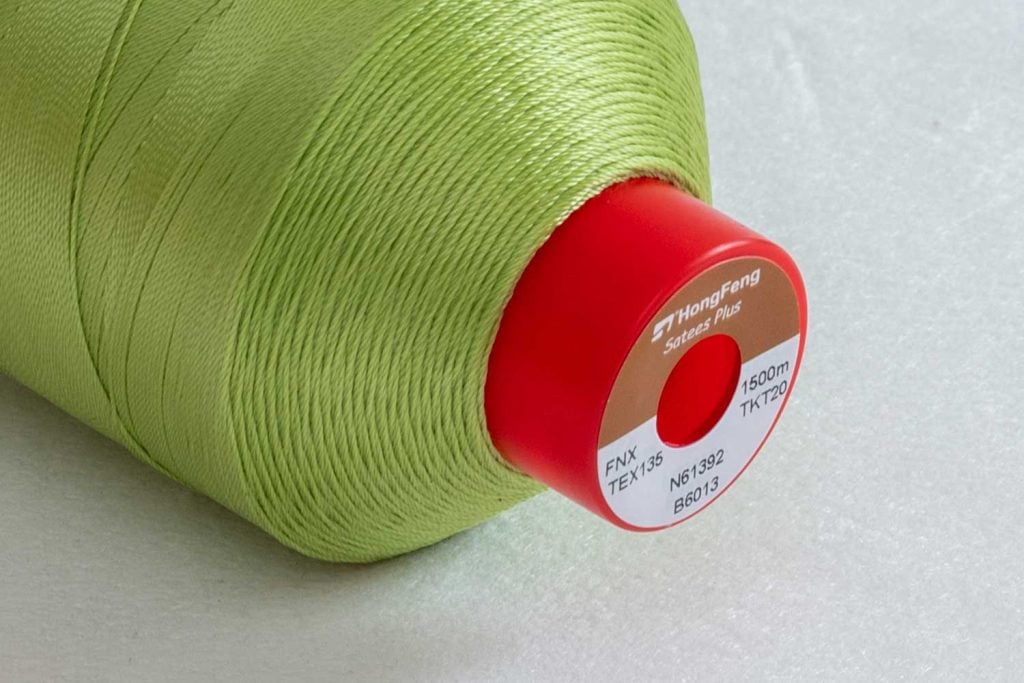
HONGFENG® bonded Thread For Sewing Machine
bonded Thread
Satess® plus Bonded Nylon 66
Hongfeng Satees® Plus is a bonded nylon thread. Hongfeng Satees® has the advantage of high tenacity and superior abrasion resistance and can improve the productivity and performance of the sewing production line due to the unique bond technology.
Doyte® plus Bonded Polyester
Hongfeng Doyte® Plus is a bonded polyester thread. Combining the advantage of excellent strength and abrasion protection, Hongfeng Doyte Plus is specifically designed to provide resistance against harsh weather.
Bonded Sewing Thread
Satess® plus Bonded Nylon and Doyte® plus Bonded Polyester threads produced by more than 200+ special processes, select high-quality environmentally-friendly nylon and polyester continuous filaments that are twisted and bonded, Honfeng® Bonded threads are strong, colorfast, mildew-resistant threads.
What is bonded thread?
Bonded thread is made of polyester and nylon. It is made of continuous filaments twisted together. After bonding, all strands of yarn are bonded together.
The bonded coating of this type of thread creates a smooth, even finish that keeps the ends together with more cohesion and resists friction and abrasion.
What is bonded thread?
Bonded thread is made of polyester and Nylon. It is made of continuous filaments twisted together. After bonding, all strands of yarn are bonded together.
The bonded coating of this type of thread creates a smooth, even finish that keeps the ends together with more cohesion and resists friction and abrasion.This means your industrial sewing process can take place at very high speeds, even with multi-directional sewing. An additional benefit of bonded thread is fray resistance for cut ends and slightly stiffer yarn that is much easier to handle for threading and needle applications.

How to choose bonded thread?
In order to choose between bonded and non-bonded thread for your industrial sewing operation, you’ll need to take all of the following factors into account:
- The speed of your industrial sewing process
- Whether your sewing is unidirectional or multidirectional
- The importance of a perfect, flat seam
- How thick and tough the stitch needs to be
- How heavy the material is
- The amount of friction and abrasion the material causes
Application of bonded thread
Bonded thread and industrial yarns are a great fit for heavy industrial applications like the manufacture of geotextiles, synthetic web slings, heavy tarps, canvas, and automotive upholstery. Increasingly, bonded threads are used to replace soft yarns in the critical industrial manufacturing of fiber optic cables and wires as ripcords, binders, or strength members. Other uses include heavy stitching applications that require light product weight overall, like automotive airbags, lifting slings, tie-downs, rock climbing gear, sporting equipment, and parachutes.
Features of Bonded Nylon Thread
Bonded Nylon Thread’s high strength-to-size ratio, abrasion resistance, sewing ease, and lower overall cost all attribute to its continued success in the industry. Bonded Nylon sewing thread can be used with most bleaches, organic solvents, most alkalis and mineral acids.
Bonded Nylon Thread stands up to heat, but is not fire retardant. It yellows at 300˚F and melts at 500˚F. Nylon has excellent resistance to mildew, aging, but will deteriorate with prolonged exposure to sunlight (UV). When sewing outdoor items that will be exposed to the sun polyester thread is recommended.
Needle And Thread Chart For Sewing Machines
The following chart compares various bonded nylon or polyester sewing thread specifications and the minimum needle sizes required
The V size is the common US measurement for twisted, multi-ply bonded nylon or polyester threads. Larger numbers indicate heavier threads.
The T sizes represent the “Tex” measurement system, where the number equals the weight in grams of 1000 meters of thread. If 1,000 meters weighs 70 grams, it is a Tex 70 thread. Larger numbers indicate heavier threads.
Please note that the “Tkt” (Ticket) sizes are equivalent to Metric “M” thread sizes used in some countries. Smaller numbers indicate heavier threads.
| Minimum NeedleUS/Metric | Thread Size: V (T) [Ticket] | Government Size | Yds/Pound | Break Strength | Diameter |
|---|---|---|---|---|---|
| 12/80 | 33 (T30) [Tkt 80] | AA | 13,800 | 1.8 lbs | .0050″ (.127mm) |
| 14/90 | 46 (T45) [Tkt 60] | B | 9,600 | 7.5 lbs | .0094″ (.238mm) |
| 16/100/ or 18/110 | 69 (T70) [Tkt 40] | E | 6,000 | 11 lbs | .0115″ (.292mm) |
| 19/120 | 92 (T90) [Tkt 30] | F | 4,200 | 14.5 lbs | .0133″ (.337mm) |
| 22/140 | 138 (T135) [Tkt 20] | FF | 3,000 | 22 lbs | .0163″ (.414mm) |
| 23/160 | 207 (T210) [Tkt 15] | 3 Cord | 2,000 | 32 lbs | .0200″ (.508mm) |
| 25/200 | 277 (T270) [Tkt 10] | 4 Cord | 1,500 | 45 lbs | .0231″ (.586mm) |
| 26/220 | 346 (T350) [Tkt 8] | 5 Cord | 1,200 | 53 lbs | .0258″ (.655mm) |
| 27/250 | 415 (T400) [Tkt 7] | 6 Cord | 1,050 | 72 lbs | .0283″ (.718mm) |
| 30/330 | 554 (T600) [Tkt 5] | 8 Cord | 655 | 83 lbs | .0326″ (.828mm) |




